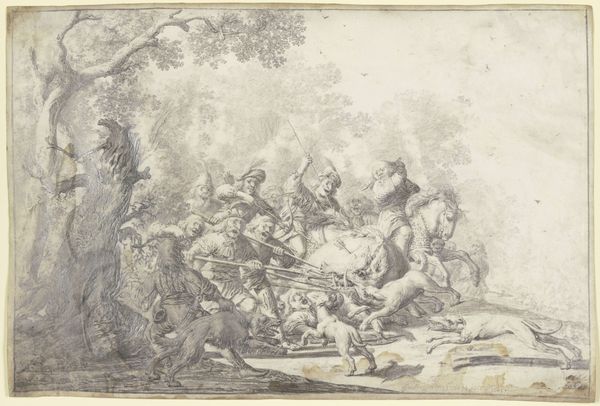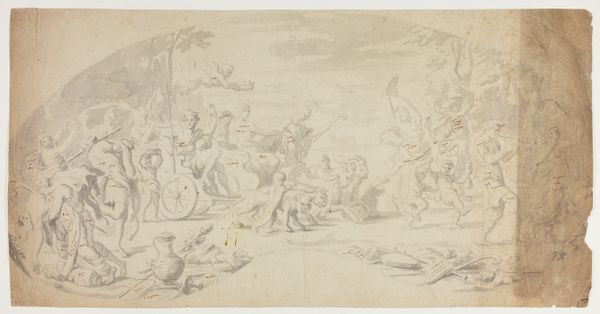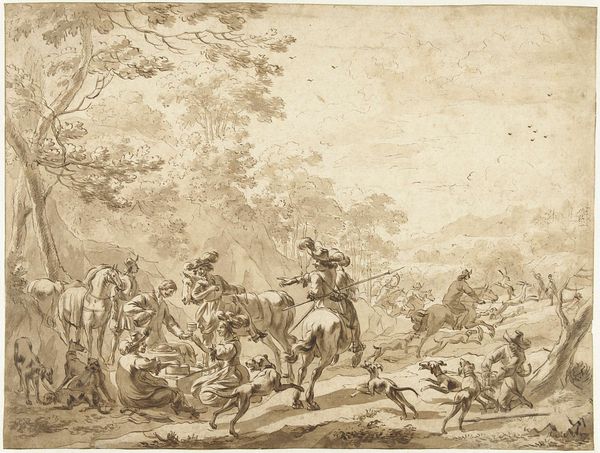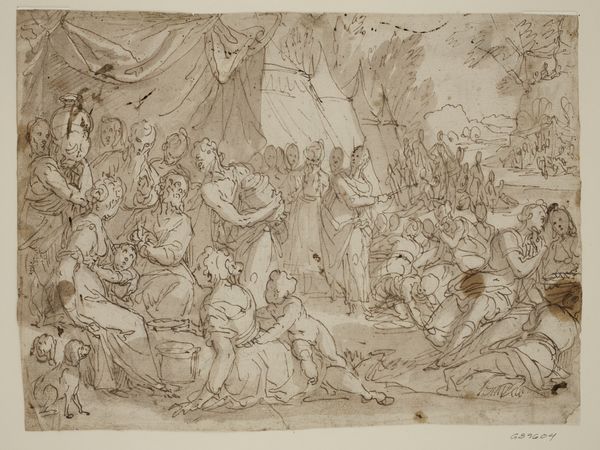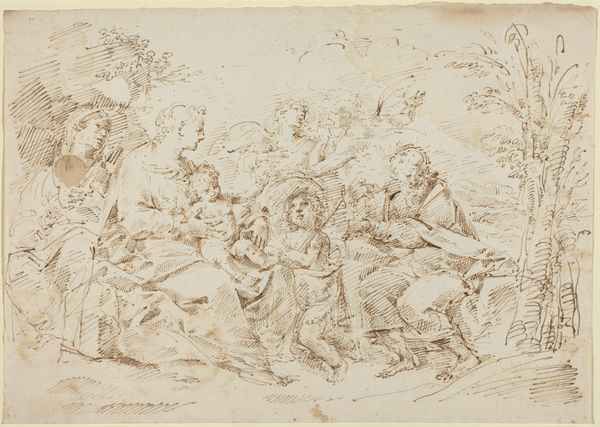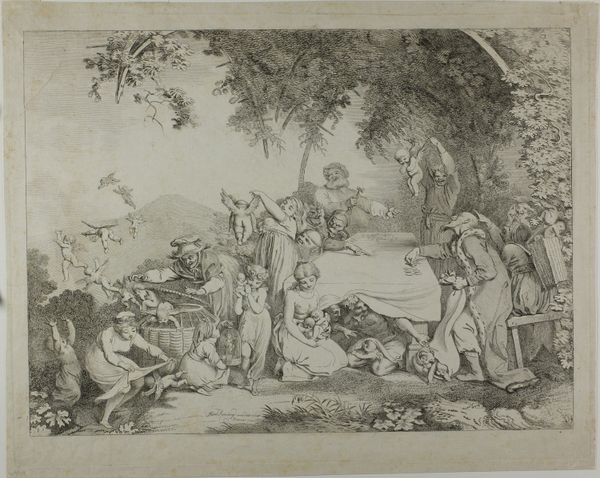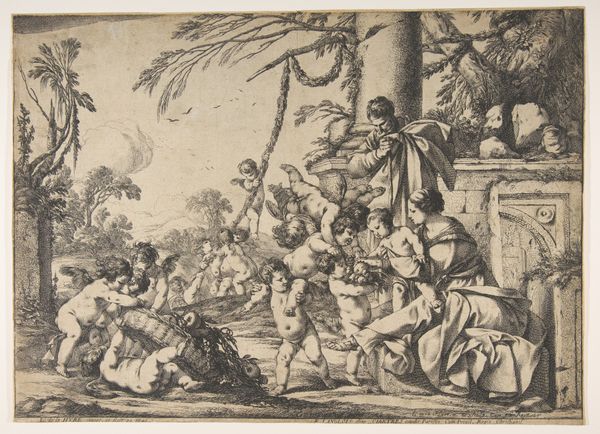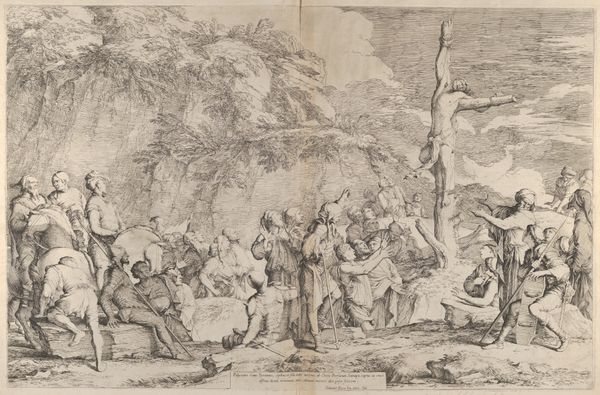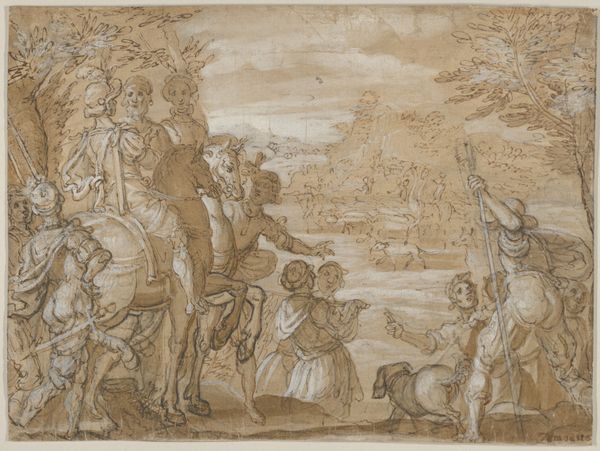
drawing, ink, pen
#
drawing
#
narrative-art
#
baroque
#
ink painting
#
landscape
#
ink
#
pen
#
history-painting
Dimensions: 15 13/16 x 22 15/16 in. (40.16 x 58.26 cm) (sheet)29 11/16 x 23 11/16 x 1 1/8 in. (75.41 x 60.17 x 2.86 cm) (outer frame)
Copyright: Public Domain
Curator: Right now we're standing in front of "The Multiplication of Loaves and Fishes," an ink and pen drawing created around 1750 by Gregorio Guglielmi, found here in the collection of the Minneapolis Institute of Art. Editor: It feels incredibly peaceful. The gathering crowd is a bit faded, almost ethereal. They seem relaxed and content, like they're soaking in the sunlight and stories rather than clamoring for food. There’s a very specific stillness. Curator: Guglielmi definitely captures a mood rather than focusing on photorealism. This scene comes to us straight from the New Testament. The drawing shows Jesus miraculously feeding a multitude with only a few loaves of bread and fishes. It’s one of the more well-known biblical stories. Editor: Yes, and even though the subject is quite charged—a miracle no less—the symbols themselves remain very subdued here. I’m trying to decode the iconography in this particular drawing, but what strikes me first is how ordinary everything seems. The Baroque flourish is certainly there, but it’s surprisingly understated. It’s as though he’s reminding us of the miracle hidden in everyday acts of generosity. The fish and bread become metonyms for far larger ideals here. Curator: I completely agree! Guglielmi's strength lies in creating such a natural setting that, at first glance, it seems like a quiet day by the water. Then you see the figure presenting the loaves and suddenly realize you're witnessing this divine act unfold. It invites contemplation, rather than just being a depiction of divine power. The loose pen strokes and grey ink wash definitely reinforce this dream-like feel. The figures have a strong presence, but also feel temporary, if that makes sense? Editor: Perfectly! This artwork shows a really interesting paradox – the rendering of divinity, sacredness, and abundance through simplicity, humility, and unassuming means. It seems that this perspective might make a point about what Guglielmi deems truly transformative. Perhaps his purpose here is not only to present the moment itself, but a reflection upon what he understands this biblical teaching to truly mean. Curator: Looking at this rendering again, it reminds me that in our fast-paced times, miracles might indeed appear differently. Thank you for reminding me of the magic that remains within our everyday, almost missed moments. Editor: Likewise, thank you. Guglielmi’s work, with its emphasis on both historical narrative and common humanity, encourages a deeper engagement with the art we see and how that resonates even centuries later.
Comments
minneapolisinstituteofart almost 2 years ago
⋮
This large, highly finished sheet was probably the definitive design for the fresco Gregorio Guglielmi executed in the refectory of the convent of Sant'Agostino in Rome because there are very few differences between this drawing and the final painting. The most obvious change is the addition around the fresco of a border of frolicking putti, who hold back feigned drapery to reveal the scene. The addition of a wide strip of paper on the right side of the sheet indicates that Guglielmi was still working out the composition when he began the drawing and did not allow himself a large enough piece of paper. Initially, Christ was at the very center of the composition, but at some later stage Guglielmi decided to include another figural group in the right foreground for balance, requiring him to extend the sheet and shift Christ slightly to the left. Christ's miraculous feeding of a crowd of five thousand with just five loaves of bread and two fish was a fitting theme for the refectory or monk's dining hall. Guglielmi's facile handling of brush and wash and his animated touch bring the scene to life. Image Caption:Gregorio Guglielmi, Multiplication of Loaves and Fishes, 1750, fresco, 19 x 32 ft., Seat of the State Attorney General of Italy, Rome (formerly the convent of Sant'Agostino)
Join the conversation
Join millions of artists and users on Artera today and experience the ultimate creative platform.



